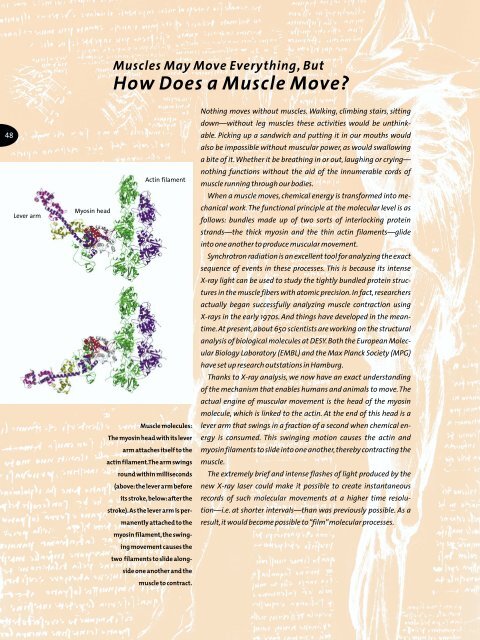TESLA Brochure - ACFA Joint Linear Collider Physics and Detector ...
TESLA Brochure - ACFA Joint Linear Collider Physics and Detector ...
TESLA Brochure - ACFA Joint Linear Collider Physics and Detector ...
You also want an ePaper? Increase the reach of your titles
YUMPU automatically turns print PDFs into web optimized ePapers that Google loves.
48<br />
Lever arm<br />
Myosin head<br />
Muscles May Move Everything, But<br />
How Does a Muscle Move?<br />
Actin filament<br />
Muscle molecules:<br />
The myosin head with its lever<br />
arm attaches itself to the<br />
actin filament.The arm swings<br />
round within milliseconds<br />
(above:the lever arm before<br />
its stroke,below:after the<br />
stroke).As the lever arm is permanently<br />
attached to the<br />
myosin filament,the swinging<br />
movement causes the<br />
two filaments to slide alongside<br />
one another <strong>and</strong> the<br />
muscle to contract.<br />
Nothing moves without muscles. Walking, climbing stairs, sitting<br />
down—without leg muscles these activities would be unthinkable.<br />
Picking up a s<strong>and</strong>wich <strong>and</strong> putting it in our mouths would<br />
also be impossible without muscular power, as would swallowing<br />
a bite of it.Whether it be breathing in or out, laughing or crying—<br />
nothing functions without the aid of the innumerable cords of<br />
muscle running through our bodies.<br />
When a muscle moves, chemical energy is transformed into mechanical<br />
work. The functional principle at the molecular level is as<br />
follows: bundles made up of two sorts of interlocking protein<br />
str<strong>and</strong>s—the thick myosin <strong>and</strong> the thin actin filaments—glide<br />
into one another to produce muscular movement.<br />
Synchrotron radiation is an excellent tool for analyzing the exact<br />
sequence of events in these processes. This is because its intense<br />
X-ray light can be used to study the tightly bundled protein structures<br />
in the muscle fibers with atomic precision. In fact,researchers<br />
actually began successfully analyzing muscle contraction using<br />
X-rays in the early 1970s. And things have developed in the meantime.<br />
At present,about 650 scientists are working on the structural<br />
analysis of biological molecules at DESY. Both the European Molecular<br />
Biology Laboratory (EMBL) <strong>and</strong> the Max Planck Society (MPG)<br />
have set up research outstations in Hamburg.<br />
Thanks to X-ray analysis, we now have an exact underst<strong>and</strong>ing<br />
of the mechanism that enables humans <strong>and</strong> animals to move.The<br />
actual engine of muscular movement is the head of the myosin<br />
molecule, which is linked to the actin. At the end of this head is a<br />
lever arm that swings in a fraction of a second when chemical energy<br />
is consumed. This swinging motion causes the actin <strong>and</strong><br />
myosin filaments to slide into one another,thereby contracting the<br />
muscle.<br />
The extremely brief <strong>and</strong> intense flashes of light produced by the<br />
new X-ray laser could make it possible to create instantaneous<br />
records of such molecular movements at a higher time resolution—i.e.<br />
at shorter intervals—than was previously possible. As a<br />
result,it would become possible to “film”molecular processes.




